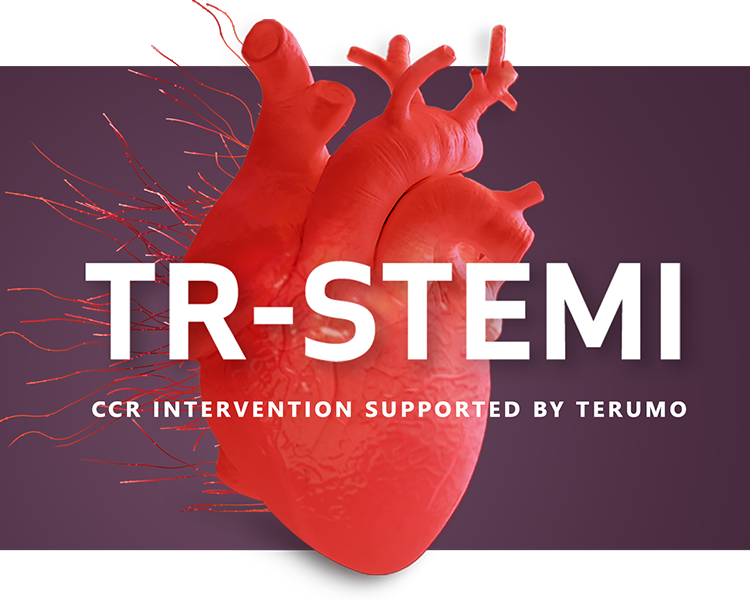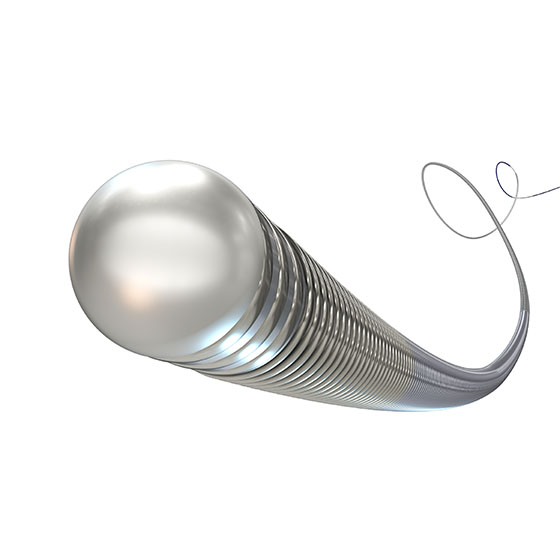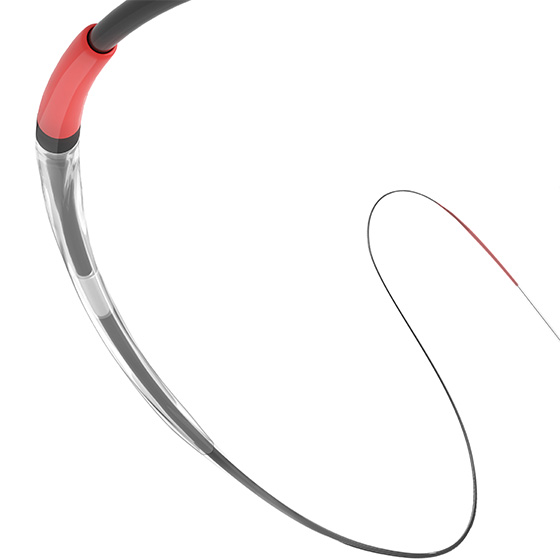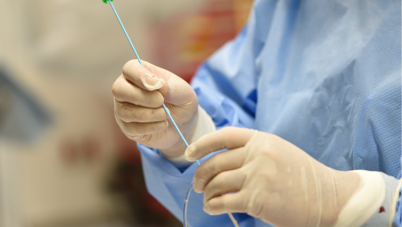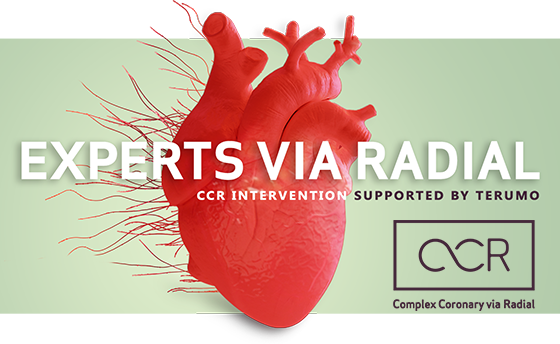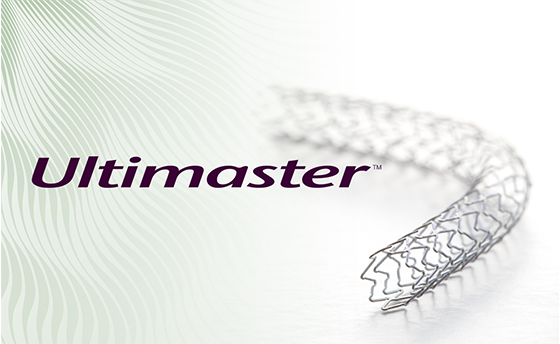Terumo Interventional Systems wants to improve radial access treatment for patients with Acute Coronary Syndromes. On this website you will find evidence of the transradial approach benefits for Coronary Angiograms, Complex PCI, and especially for Acute ST-Elevation Myocardial Infarction (STEMI) treatment.

According to GRACE (Global Registry of Acute Coronary Events) and ENACT (European Network for Acute Coronary Treatment), of all registered acute coronary events, Primary PCI is performed in 24%-26% of the cases. 1
The European Society of Cardiology 2017 guidelines gave a Class IA recommendation for the radial approach over the femoral one for patients with STEMI.2
The American Heart Association proposes and supports a “radial-first” strategy for patients with acute coronary syndromes. 3
Benefits of transradial approach over the femoral one for patients with STEMI:
Low morbidity and mortality. 4
Less bleeding complications. 3
Lower risk of Acute Kidney Injury. 3
Faster treatment/early discharge, even the same day. 3
Improves patients’ quality of life. 3
Less use of medical resources. 3
Low cost procedures. 3
Dr. Alejandro Álvarez Iorio is an interventional cardiologist from the province of Buenos Aires in Argentina. In this interview he explains the current situation of STEMI patients and the advantages and opportunities of the transradial approach for them.
TR-STEMI solution wants to:
Improve survival rates of patients with STEMI.5
Patients who need a Primary PCI through radial access as a standard approach.
Lower mortality rate in STEMI patients. 8
Radial Access reduces access site related bleeding complications and, therefore, it has a lower mortality rate.
Reduce up to 5 steps in the Primary PCI procedure. 5
Help to reduce D2B and Puncture to Balloon time, as well as the number of devices used, through the universal transradial guide catheter strategy.
Reduced healthcare costs for STEMI patients. 5
Radial access reduces mortality rate and healthcare costs of STEMI patients.
Drug-eluting stent and STEMI patients. 6
This is a modern technology which can achieve early healing and has shown excellent results in STEMI patients.
Get to know Terumo’s solution opportunities for transradial approach in STEMI patients you can take advantage of.
For more information
Evidence
A randomized comparison of Radial Vs. femoral access for coronary intervention in ACS (RIVAL)
Transradial approach offers safe and effective vascular access.
The primary outcome of a clinical trial which compared radial versus femoral access showed that the rate of death, myocardial infraction, stroke, and non-CABG-related major bleeding at 30 days was 3.7% of the number of patients in the radial access group compared with 4.0% in the femoral group (hazard ratio [HR] 0·92, 95% CI 0·72–1·17; p=0·50). 2
Transradial access have a lower rate of local vascular complications.
At 30 days, 3% of the patients in the radial group had large hematoma, compared with 1.19% in the femoral group (HR 0·40, 95% CI 0·28–0·57; p<0·0001). 2
Pseudoaneurysm needing closure occurred in 0.19% of the patients in the radial group, compared with 0.65% in the femoral group (HR 0·30, 95% CI 0·13–0·71; p=0·006). 2

Incidence of major bleeding events for patients undergoing radial versus femoral approach in randomized trials.
Radial versus femoral access MATRIX trial showed that in patients with acute coronary syndrome, radial access was associated with lower rates of net adverse clinical events compared with femoral access.
Radial access is associated with lower rates of adverse clinical events compared with femoral access at 1 year follow up. 8
Net adverse clinical events, defined as the composite of non-coronary artery bypass graft-related major bleeding, or major adverse cardiovascular events (15·2% vs. 17·2%; 0·87, 0·78–0·97; p=0·0128). 8
TRA also lowers the risk of bleeding and all-cause mortality. Bleeding, all-cause mortality, and BARC type 3 or 5 bleeding were lower in the radial group than in the femoral group (relative risk [RR], 0.67; 95% CI, 0.49–0.92; p=0.013). Radial access was also associated with a lower all-cause mortality (RR, 0.72; 95% CI, 0.53–0.99; p=0.045). 8

Incidence of major bleeding events for patients undergoing radial versus femoral approach in randomized trials.
Impact of a single universal guiding catheter on door-to-balloon time in primary transradial coronary intervention for ST segment elevation myocardial infraction. 5
These were the findings of a comparative research between STEMI patients who underwent transradial Primary PCI with a single guiding catheter (Ikari Left-Coronary Guiding Catheter, IL group) vs. patients with conventional transradial Primary PCI: 5
Reduction of door-to-balloon (D2B) time using a single universal guiding catheter (Ikari-Left catheter). 5
The D2B time was significantly shorter in the IL group (55 ± 16 vs. 63 ± 17 min, respectively; p = 0.01). 5
Puncture-to-balloon time was also significantly shorter in the IL group (15 ± 11 min vs. 25 ± 11 min, respectively; p = 0.001). 5
In this procedure, we can skip a total of five steps compared with a conventional procedure(two catheter insertions, two catheter removals, and one catheter engagement), (1 (IQR 1-1) vs. 3 (IQR 3-3).
With a single universal guiding catheter, we can perform both angiography and Primary PCI.
Reducing total ischemic time 5 is important for ST segment elevation myocardial infarction (STEMI).
Incidence of major bleeding events for patients undergoing radial versus femoral approach in randomized trials.
Teflon coated guidewire vs. hydrophilic coated guidewire 1.5mm J-Tip shape (Baby-J)
The variations of the radial artery and the subclavian artery anatomic structure can represent a challenge for guidewire advancement and catheter manipulation during transradial procedures.
Catheter passage rate was 92% in anatomic variations vs. 42% with teflon coated guidewire.
8% reduction of fluoroscopy time vs. conventional teflon coated guidewire.
18% reduction of catheter placement time vs. conventional teflon coated guidewire.
A guidewire with a 1.5mm J-Tip shape has a lot of advantages over hydrophilic coated guidewire angled tip shape, such as
Avoids contact with the blood vessel wall.
Less trauma and related artery spasms.
In most cases, it allows catheter movement without fluoroscopy, even in small radial arteries.
Success Stories
Get to know the whole list of success stories.
Cardiologist Álvaro Contreras Villaseñor, from Mexico City, explains some TR-STEMI cases and Terumo’s solution for them.
Author: Dr. Álvaro Contreras Villaseñor

